Get Ready To Ride! Learn The Essential Steps For a Smooth Kiteboarding Water Start
This blog post provides an in-depth look at the five key steps necessary to learn how to water start when kiteboarding or kitesurfing. The first step is to get comfortable with the kite, learning how to launch and land it, as well as understanding its wind window. The second step involves compressing your body into a smaller package, which involves using the power of the kite to pull you through the water and upwind. Step three is getting onto the board, where you will need to carefully balance yourself in order for the board to stay flat on the water. Step four is edging, which involves making sure your board is parallel with the kite line and facing toward the center of the window so that when you edge, you don't get sent off course. The fifth and final step is to twist and lean back, which involves putting your weight over the back foot and stacking the shoulders over both knees so that when the kite pulls up or downwind, it will keep the board riding in a straight line. It's important to remember not to rush these steps and to always have fun while you learn. By following these five steps, anyone can learn how to water start in no time!
Kiteboarding and kitesurfing can seem daunting at first, but by following the five key steps outlined in this blog post, it's easy for anyone to learn and enjoy the sport. It's important to remember to take your time and have fun while learning, and before you know it, you'll be up and riding with ease.
Hey, what's up guys? Blake from MACkite here, and today I'm going to teach you how to perfect your kiteboarding water starts.
So this is a really fun and monumental little step in your progression as a kiteboarder. Because up until now, you've been learning about the wind, learning how it all works, how to set it up, and how to body drag and fly the kite. Now we're ready to get to the fun part where we actually use the board and apply the kite and the board together. So without further ado, let's get into the kiteboarding water start.
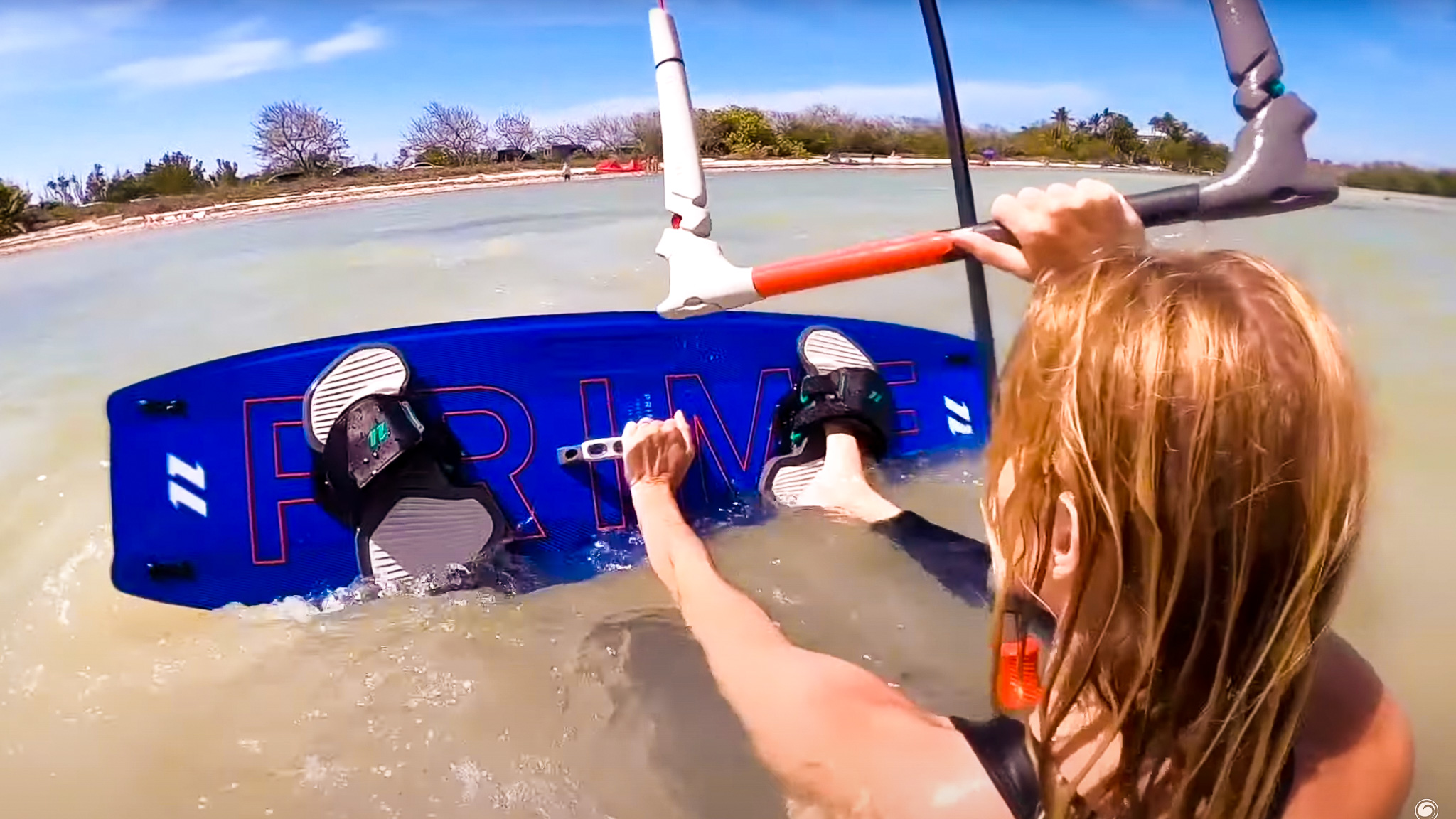
Step 1 | Getting Comfortable Flying Your Kite With One Hand
For the first step here, you will need to know how to fly your kite with one hand. You're going to have one hand on the bar, one hand on the board, and put the board on your feet.
And this is something that's very important for you. Before you get into trying to just go for it, make sure that you've done the prior prerequisite steps before this, where you know how to fly the kite, you know how to body drag. You understand the concept of sheeting in and sheeting out, and that'll make your life so much easier.
With one hand on the bar, you want to keep your hand in the middle so that you have less steering of the kite. If you can't keep it still above you without looking, then just try and keep it moving back and forth.
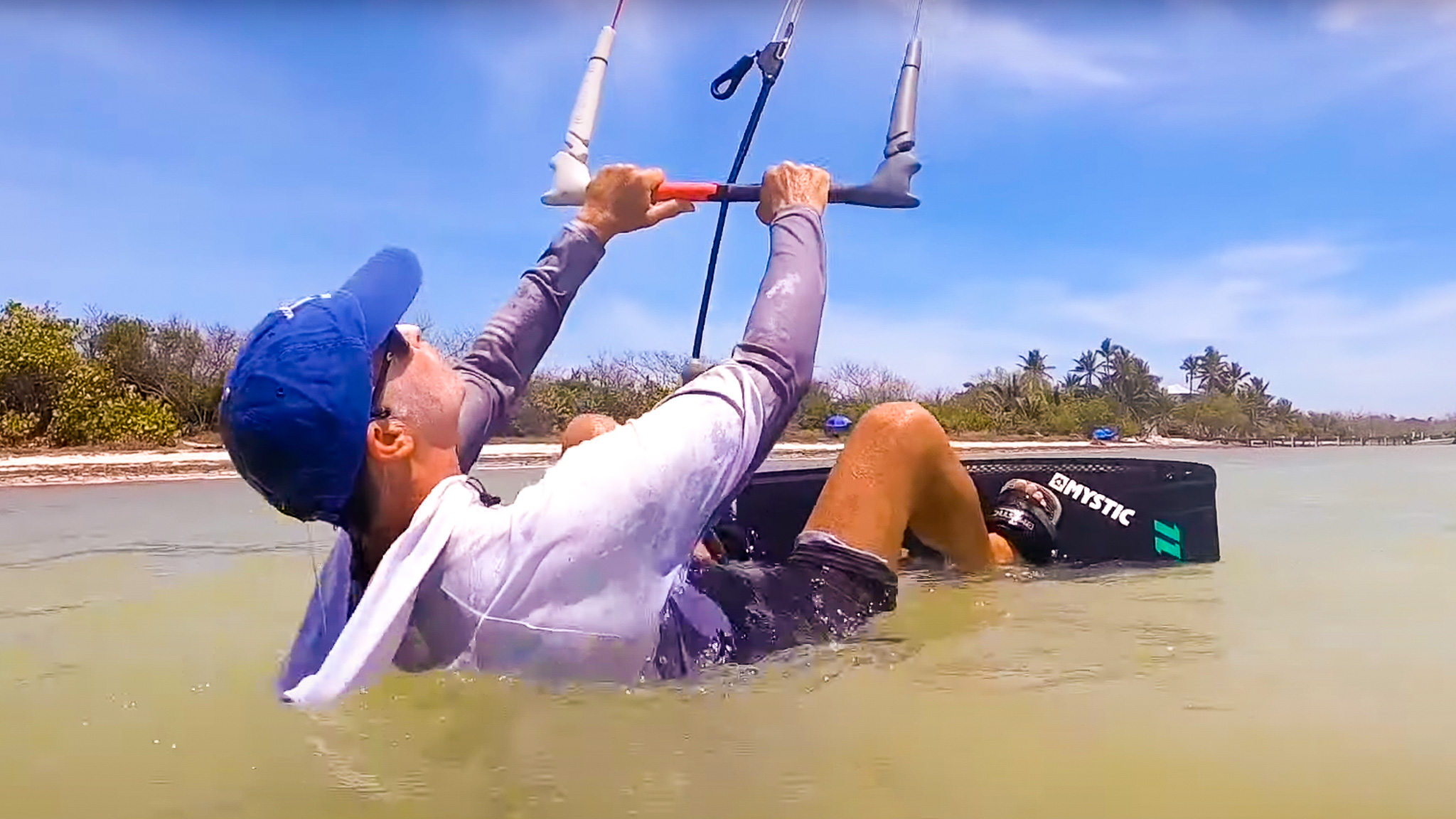
Step 2 | Bringing Your Knees to Your Chest
So step number two is knees to your chest. The smaller you are, the easier it will be to start. So if you need to do some yoga before this so that you can bring your knees closer to your chest, I'd recommend doing that or maybe doing a nice little stretch before you get out there. But if you can really bring your knees to your chest like that, you'll be able to rock onto the board much easier.
One of the most common mistakes in water starts is people's legs are too straight, and then you're just going to be kind of like a lever where your whole body goes up, and then you either go face forward or you fall on your back, and the board slides out on you.
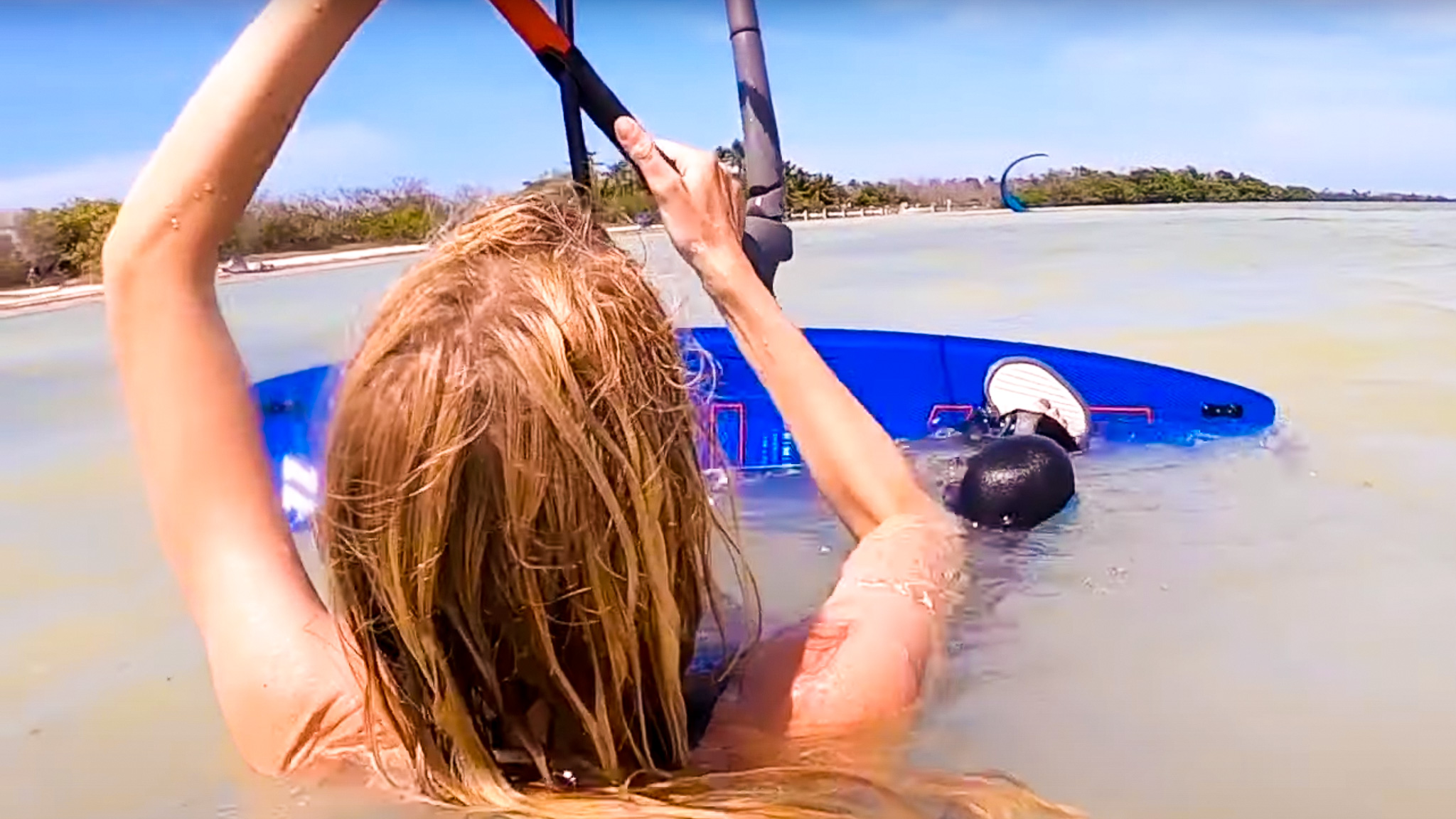
Step 3 | Powering Up Your Kite
So step number three is to send the kite. So when you start off, you will want to send the kite lightly. Probably won't be enough power, but it's better to start light than too much. You go all out and send the kite. Then it will send you flying, or just yank you out of the water, and you're going too fast. So small steps here and just take it little by little, bringing your kite from 12:00, straight overhead, and down.
One common mistake is to send the kite too slowly. The kite will just go to the edge of the wind window. So if you need a little bit more power and you feel that starting at 12:00 is just not enough to get you up. And what you do is you just simply put the kite at the other side of the window, either 1:00 or 11:00, depending on how much more power you need.
If it's really light wind, you can bring it to 2:00 or 10:00, and then that starts the kite at one side of the window so that when you send it down, it goes straight through the power zone, catches as much wind as you can and pulls you into that start. You're going to do a figure-eight, starting from one side of the window to the other, and going down. You're going to pull in on the bar as you send it down to catch as much wind and power as possible. And once that kite is down, you're going to send it back up. And as it's going back up is when you're going to sheet out.
So think of this as pumping the kite. You're going to pull in, send it down, steer it up, and then as the kite travels up, you want to push out because what pushing out on the bar does is it opens the canopy of the kite and allows it to rise and lift quicker than if you had it pulled in.
So if you keep the bar pulled in as the kite's going up, then it's actually going to be keeping it down slower. Whereas if you simply sheet out on the bar as it's traveling up, it'll launch into the sky and shoot up there much quicker. If you find yourself holding in and pulling it on the bar, try to loosen your grip on it, and fly it more with your fingertips.
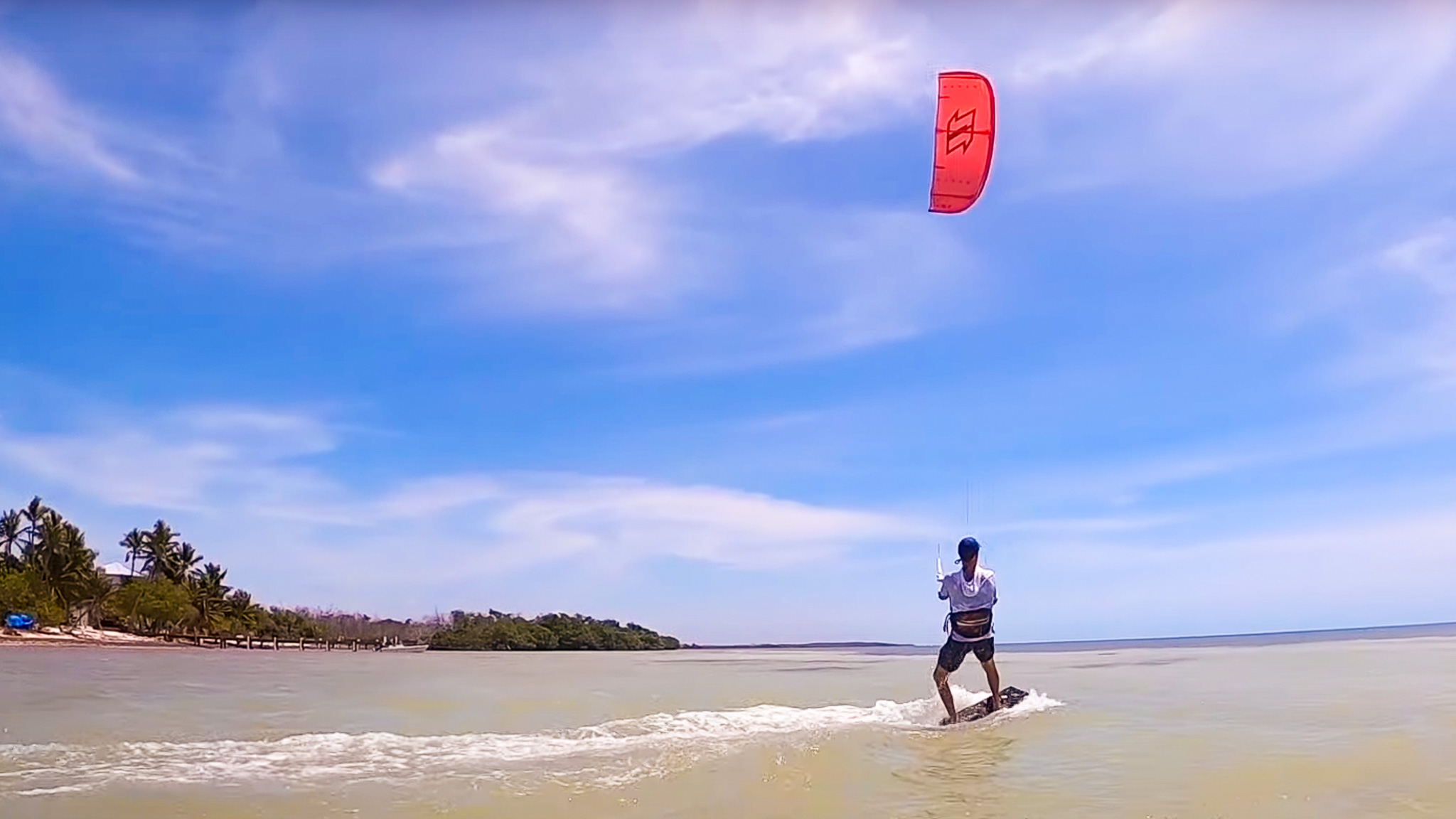
Step 4 | Follow the Kite
Step number four is to follow the pull of the kite. Another one of the most common mistakes as a beginner, especially if you've tried this already, is you'll notice yourself trying to edge right away. And what that does is it kind of kills all of the power that you're using to send the kite and pull you up because you're edging against the kite rather than working with it.
You want your board to be flat because if it's on edge, one, you're balancing all your weight on the edge of the board, and two, if you're not perfectly balanced, the edge is just going to sink back into the water, and you're going to kill all the power. So as the kite sends and you feel it pulling you up, you're going to roll onto the board and get the board flat and follow the kite.
You're going to make sure that the board is parallel with the kite line, and you want your body to be facing toward the middle of the window so that when you edge, you don't get sent into one side or another. And as you follow the pull of the kite, it will start pulling you up onto the board.
Now you're going to feel your board as it starts to plane, and that's when you can start to really edge into the power of the kite. You want to make sure that you keep your flat base and then just use the tip of the board to edge so that if at any point you need to release the power, you can just tip off the edge, and it's going to take away the pull.
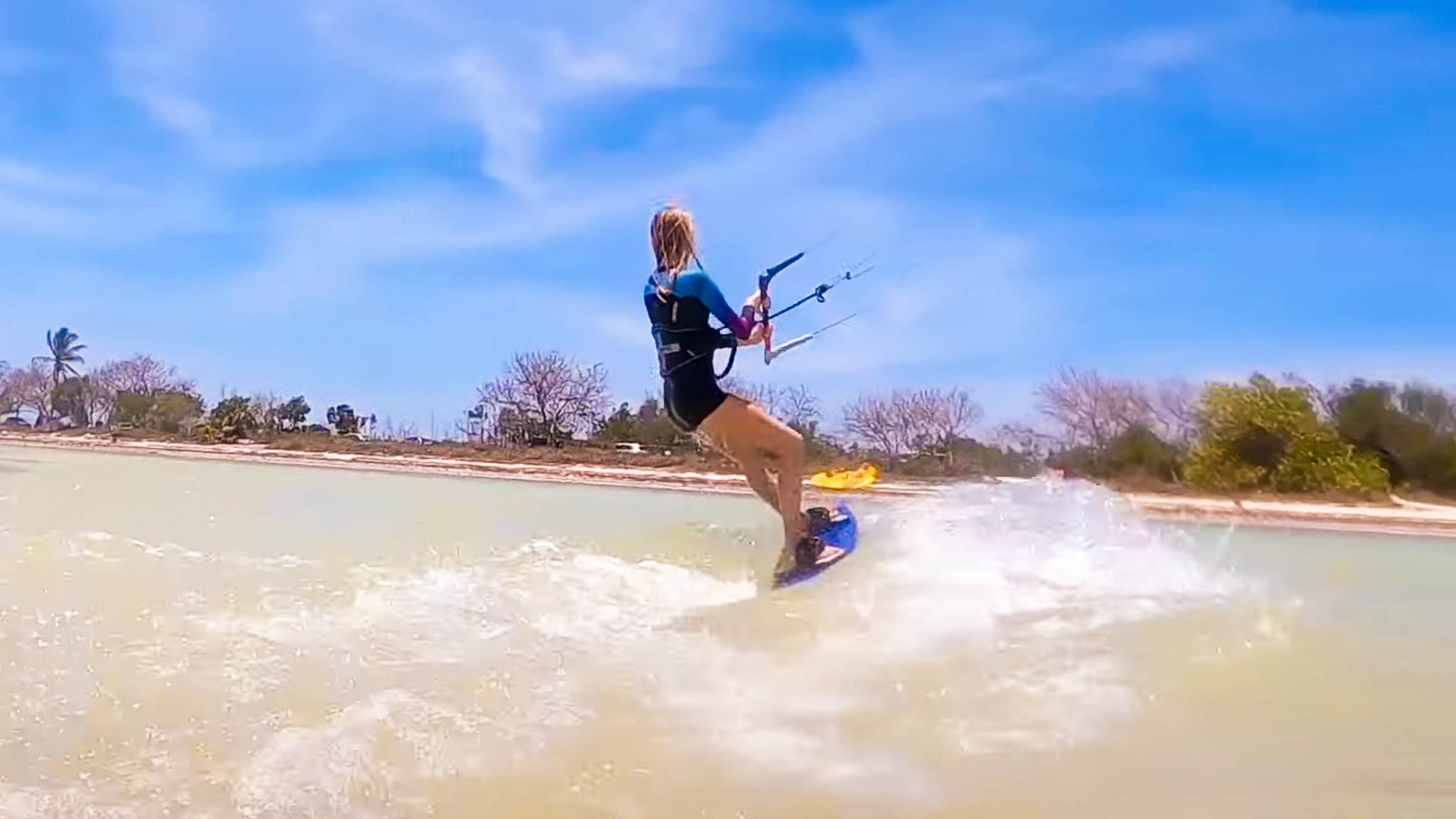
Step 5 | Lean Back
Step number five is to twist and lean back. So if you are standing upright, then the kite is pulling you downwind as your board's riding this way. So as you start and once you're up on the board and you've done all the previous steps, now you feel yourself starting to get it. You're excited about riding the board. As you're riding, you will want to twist and lean back because what this does is you twist and lean back. It puts your weight over your back foot. Then your shoulders are stacked over both of your knees, and you're equally weighting the two knees.
Once you're keeping up with the kite and you feel your speed is good, and you start to ride the board, and you get the hang of it, this is where you're going to slowly start to sheet out, twist, open up and lean your weight back over your back knee. Kind of straighten your front leg. What opening up and sheeting out like that does is it also adjusts the angle of attack of your kite so that it'll allow you to ride more upwind.
Once you feel like you got the hang of it, and you're feeling speed, try to get your arms, shoulders, and upper body more relaxed so that when the kite pulls up or downwind, it will keep your board riding in a straight line.
Take Your Time
Take your time—don't rush it. And most importantly, make sure you're having fun, because if you're not having fun, and you're getting frustrated, and you're getting upset, which trust me, I know the feeling, you try and take deep breaths and just think about what you're doing.
So every time you fall, try to stop and reset yourself. Take a few deep breaths and think about what you're about to do. Even close your eyes and visualize the steps that we're talking about. And watch other videos as well because there are so many great ones out there.

Recent Posts
-
Kiteboarding Tricks | How To Do A Backroll Hat Drag
You can use a little creativity to switch up even the more basic tricks and add a little f …26th Jul 2024 -
KT Ginxu Step-Bottom and Foil Drive Systems | A Perfect Match?
The step-bottom feature of the KT Ginxu foilboards is a big help in releasing the surface te …24th Jul 2024 -
Starboard Ace Air Inflatable Wing Foilboard Review
It's Wing Wednesday, and today Tucker's got an inflatable foilboard, the 2024 Starboard Ace …23rd Jul 2024




